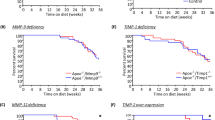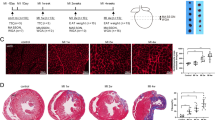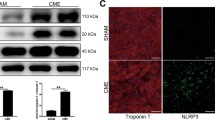Abstract
Aim:
The examine the cardiac hypertrophy and fibrosis in apolipoprotein E-deficient mice (ApoE−/− mice) fed a “Western-style diet” and the effect of simvastatin intervention.
Methods:
Male ApoE−/− mice (n=36) were fed a “Western-style diet” from the age of 8 weeks. After 16 weeks, they were randomly given either simvastatin (25 mg·kg−1·d−1) or normal saline (control group) by gavage for 8, 16, or 24 weeks. The left ventricular (LV) wall thickness and diameter of the myocardial cells were determined with Hematoxylin-Eosin stain, and the level of fibrosis of the myocardial matrix was assessed with Masson stain. Real-time quantitative polymerase chain reaction and Western blotting analysis were used to determine the mRNA and protein expression of matrix metalloproteinase-9 (MMP-9), Cathepsin S (Cat S), and the peroxisome proliferator-activated receptors (PPARs) in the myocardium of ApoE−/− mice.
Results:
ApoE−/− mice fed a “Western-style diet” showed an significant age-dependent increase in total cholesterol (TC), LV wall thickness, myocardial cell diameter and LV collagen content (P<0.05). The simvastatin treatment group showed significantly reduced LV wall thickness, myocardial cell diameters and LV collagen content at 40 weeks when compared with the control group (P<0.05). Furthermore, treatment with simvastatin also significantly inhibited the mRNA and protein expressions of MMP-9 and Cat S as well as increased the mRNA and protein expressions of PPAR alpha and PPAR gamma at 32 and 40 weeks compared with the control group (P<0.05).
Conclusion:
ApoE−/− mice fed a “Western-style diet” had cardiac hypertrophy and fibrosis, which worsened with age. Simvastatin treatment inhibits the development of cardiac hypertrophy and fibrosis, and this effect may be mediated through increased levels of PPAR alpha and PPAR gamma and reduced levels of TC, MMP-9, and Cat S.
Similar content being viewed by others
Log in or create a free account to read this content
Gain free access to this article, as well as selected content from this journal and more on nature.com
or
References
Lee TM, Chou TF, Tsai CH . Association of pravastatin and left ventricular mass in hypercholesterolemic patients: role of 8-iso-prostaglandin f2alpha formation. J Cardiovasc Pharmacol 2002; 40: 868–74.
Sundström J, Lind L, Vessby B, Andrén B, Aro A, Lithell H . Dyslipidemia and an unfavorable fatty acid profile predict left ventricular hypertrophy 20 years later. Circulation 2001; 103: 836–41.
Wu JH, Hagaman J, Kim S, Reddick RL, Maeda N . Aortic constriction exacerbates atherosclerosis and induces cardiac dysfunction in mice lacking apolipoprotein E. Arterioscler Thromb Vasc Biol 2002; 22: 469–75.
Wang YX . Cardiovascular functional phenotypes and pharmacological responses in apolipoprotein E deficient mice. Neurobiol Aging 2005; 26: 309–16.
Takemoto M, Node K, Nakagami H, Liao Y, Grimm M, Takemoto Y, et al. Statins as antioxidant therapy for preventing cardiac myocyte hypertrophy. J Clin Invest 2001; 108: 1429–37.
Planavila A, Laguna JC, Vázquez-Carrera M . Atorvastatin improves peroxisome proliferator-activated receptor signaling in cardiac hypertrophy by preventing nuclear factor-kappa B activation. Biochim Biophys Acta 2005; 1687: 76–83.
Ye P, Sheng L, Zhang C, Liu Y . Atorvastatin attenuating down-regulation of peroxisome proliferator-activated receptor gamma in preventing cardiac hypertrophy of rats in vitro and in vivo. J Pharm Pharm Sci 2006; 9: 365–75.
Senthil V, Chen SN, Tsybouleva N, Halder T, Nagueh SF, Willerson JT, et al. Prevention of cardiac hypertrophy by atorvastatin in a transgenic rabbit model of human hypertrophic cardiomyopathy. Circ Res 2005; 97: 285–92.
Caglayan E, Stauber B, Collins AR, Lyon CJ, Yin F, Liu J, et al. Differential roles of cardiomyocyte and macrophage peroxisome proliferator-activated receptor gamma in cardiac fibrosis. Diabetes 2008; 57: 2470–9.
Roldán V, Marín F, Gimeno JR, Ruiz-Espejo F, González J, Feliu E, et al. Matrix metalloproteinases and tissue remodeling in hypertrophic cardiomyopathy. Am Heart J 2008; 156: 85–91.
Cheng XW, Obata K, Kuzuya M, Izawa H, Nakamura K, Asai E, et al. Elastolytic cathepsin induction/activation system exists in myocardium and is upregulated in hypertensive heart failure. Hypertension 2006; 48: 979–87.
Singh AP, Singh M, Balakumar P . Effect of mast cell stabilizers in hyperhomocysteinemia-induced cardiac hypertrophy in rats. J Cardiovasc Pharmacol 2008; 51: 596–604.
Nakashima Y, Plump AS, Raines EW, Breslow JL, Ross R . ApoE-deficient mice develop lesions of all phases of atherosclerosis throughout the arterial tree. Arterioscler Thromb 1994; 14: 133–40.
Smeets PJ, Teunissen BE, Willemsen PH, van Nieuwenhoven FA, Brouns AE, Janssen BJ, et al. Cardiac hypertrophy is enhanced in PPAR alpha−/− mice in response to chronic pressure overload. Cardiovasc Res 2008; 78: 79–89.
Yamamoto K, Ohki R, Lee RT, Ikeda U, Shimada K . Peroxisome proliferator-activated receptor gamma activators inhibit cardiac hypertrophy in cardiac myocytes. Circulation 2001; 104: 1670–5.
Duan SZ, Ivashchenko CY, Russell MW, Milstone DS, Mortensen RM . Cardiomyocyte-specific knockout and agonist of peroxisome proliferator-activated receptor-gamma both induce cardiac hypertrophy in mice. Circ Res 2005; 97: 372–9.
Raffetto JD, Khalil RA . Matrix metalloproteinases and their inhibitors in vascular remodeling and vascular disease. Biochem Pharmacol 2008; 75: 346–59.
López B, González A, Díez J . Role of matrix metalloproteinases in hypertension-associated cardiac fibrosis. Curr Opin Nephrol Hypertens 2004; 13: 197–204.
Henderson BC, Sen U, Reynolds C, Moshal KS, Ovechkin A, Tyagi N, et al. Reversal of systemic hypertension-associated cardiac remodeling in chronic pressure overload myocardium by ciglitazone. Int J Biol Sci 2007; 3: 385–92.
Cheng XW, Murohara T, Kuzuya M, Izawa H, Sasaki T, Obata K, et al. Superoxide-dependent cathepsin activation is associated with hypertensive myocardial remodeling and represents a target for angiotensin II type 1 receptor blocker treatment. Am J Pathol 2008; 173: 358–69.
Cheng XW, Kuzuya M, Sasaki T, Arakawa K, Kanda S, Sumi D, et al. Increased expression of elastolytic cysteine proteases, cathepsins S and K, in the neointima of balloon-injured rat carotid arteries. Am J Pathol 2004; 164: 243–51.
Tang Q, Cai J, Shen D, Bian Z, Yan L, Wang YX, et al. Lysosomal cysteine peptidase cathepsin L protects against cardiac hypertrophy through blocking AKT/GSK3beta signaling. J Mol Med 2009; 87: 249–60.
Nakagami H, Jensen KS, Liao JK . A novel pleiotropic effect of statins: prevention of cardiac hypertrophy by cholesterol-independent mechanisms. Ann Med 2003; 35: 398–403.
Rohini A, Agrawal N, Koyani CN, Singh R . Molecular targets and regulators of cardiac hypertrophy. Pharmacol Res 2010; 61; 269–80.
Takimoto E, Kass DA . Role of oxidative stress in cardiac hypertrophy and remodeling. Hypertension 2007; 49: 241–8.
Kang BY, Wang W, Palade P, Sharma SG, Mehta JL . Cardiac hypertrophy during hypercholesterolemia and its amelioration with rosuvastatin and amlodipine. J Cardiovasc Pharmacol 2009; 54: 327–34.
Choi EY, Chang W, Lim S, Song BW, Cha MJ, Kim HJ, et al. Rosuvastatin inhibits norepinephrine-induced cardiac hypertrophy via suppression of Gh. Eur J Pharmacol 2010; 627: 56–62.
Acknowledgements
This work was supported by grants from the National Natural Science Foundation of China (No 30872713) and the Beijing Natural Science Foundation of China (No 7082020, 7082083).
Author information
Authors and Affiliations
Corresponding author
Rights and permissions
About this article
Cite this article
Qin, Yw., Ye, P., He, Jq. et al. Simvastatin inhibited cardiac hypertrophy and fibrosis in apolipoprotein E-deficient mice fed a “Western-style diet” by increasing PPAR α and γ expression and reducing TC, MMP-9, and Cat S levels. Acta Pharmacol Sin 31, 1350–1358 (2010). https://doi.org/10.1038/aps.2010.109
Received:
Accepted:
Published:
Issue date:
DOI: https://doi.org/10.1038/aps.2010.109
Keywords
This article is cited by
-
Simvastatin Significantly Reduced Alcohol-Induced Cardiac Damage in Adolescent Mice
Cardiovascular Toxicology (2024)
-
The protective effects of gallic acid and SGK1 inhibitor on cardiac damage and genes involved in Ca2+ homeostasis in an isolated heart model of ischemia/reperfusion injury in rat
Naunyn-Schmiedeberg's Archives of Pharmacology (2024)
-
Proteomic analysis reveals activation of platelet- and fibrosis-related pathways in hearts of ApoE−/− mice exposed to diesel exhaust particles
Scientific Reports (2023)
-
Crossroads between peripheral atherosclerosis, western-type diet and skeletal muscle pathophysiology: emphasis on apolipoprotein E deficiency and peripheral arterial disease
Journal of Biomedical Science (2017)
-
Modulation of cholesterol-related gene expression by ergosterol and ergosterol-enriched extracts obtained from Agaricus bisporus
European Journal of Nutrition (2016)



